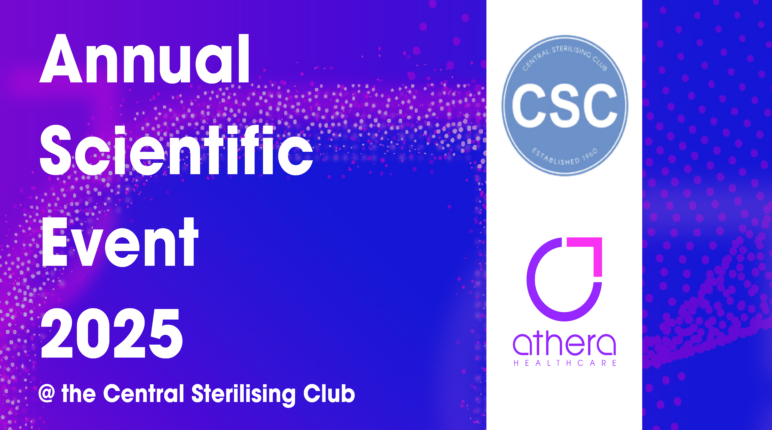Events
Key Insights from the CSC Annual Scientific Event 2025

The Central Sterilising Club’s 2025 Annual Scientific Meeting brought together decontamination and sterile services professionals for two days of critical discussions on patient safety, innovation, and industry challenges. Here’s what stood out to us:
A Captivating Opening Sets the Tone
Sulisiti Holmes, Head of Decontamination and Incident Reporting Investigation Centre, serves as the strategic lead for medical device safety and decontamination in NHS Scotland, opened with a captivating yet serious message: assumptions in decontamination lead to critical risks.
Her involvement in the Phaco handpiece incident and Particle W revealed critical assumptions about effective decontamination within clinical teams, opening an intense investigation into the root issue.
Through effective persistence and enhanced technology, the results in determining the cause has helped evolve for clear Instructions for Use (IFUs), but challenges around communication, incident reporting, and sharing findings remain. Holmes emphasised that community collaboration is crucial to fostering accountability, reporting incidents, and building partnerships between manufacturers and decontamination teams.

Theatres: the challenge of siloed working
It was a profound moment when the challenges in Theatre were highlighted, with CSC voting overwhelmingly that communication between SSD and theatres needs significant improvement— something we at Athera have been tackling for sometime.
It’s clear that patient safety, efficiency, financial sustainability, and governance, would be catapulted ahead if greater theatre/SSD collaboration was actively pursued, not just a conversation. And this is no longer just theoretical: we’re already seeing a shift as more departments seek innovative solutions like ours to bridge this gap. It’s exciting— we’re going to see departments working together like never before, backed by technology and experts dedicated to advancing this collaboration.
Imagine a way of working where predictive analytics help surgical and SSD teams prioritise surgical lists, dynamically adjusting them based on patient risk scores, instrument availability, and resource limitations. The future is coming!
Automated vs. Manual Wash Processes in ERU
Discussions around Automated vs. Manual Wash Processes in ERU emphasised the need for consistent application. AED Jim Tinsdale shared a practical checklist of considerations when adopting new automated technology – advocating for better Track & Trace mechanisms to ensure compatibility, reinforcing the importance of automation wherever possible.
The UHB Trial for Khamsin, led by Sharon and her team, showcased effective collaboration by supplier and service. By doubling scope productivity from one scope per wash to two, they addressed contamination issues previously undetected by traditional MW, EWD, and cabinet processes. The study has prompted considerations on tracking time (correct SOP) at manual wash stations, monitoring productivity, and evaluating the effectiveness of patient safety, productivity, staff wellbeing, sustainability and costs (£5 per scope processed).

Addressing the Clinical Risk of Implants
The Clinical Risk of Implants discussion exposed gaps in UDI tracking, limiting precise traceability of implants to specific patient sites. Over 16,000 devices were destroyed within 12 months, requiring £50,000 in labour costs to eliminate out of date stock. Optimised stock management and traceability solutions are imperative to preventing unnecessary losses.
Navigating MDR Regulations
The transition from MDD to MDR Regulations continues, presenting challenges with implant cards and limited UK exemptions under MHRA guidance. A proposal for implant cards to include reporting websites aims to improve incident tracking and compliance.
At Athera Healthcare, we’re continually exploring how to support NHS professionals through this regulatory change. From leveraging our existing solutions to developing new tools, we’re collaborating with our customers and industry partners to navigate the transition to MDR compliance. Want to get involved? Speak to our Sales Team.
Innovations of the future.
Finally, BiCarmed innovation has emerged as a promising alternative to ultrasonic solutions, offering greater efficiency, improved interoperability, and a 34% reduction in non-conformances—reinforcing its potential as a safer and more environmentally friendly solution.
Final thoughts
Industry-wide collaboration remains the driving force behind improving decontamination practices, ensuring patient safety, and pushing forward regulatory innovation. We believe that together, we can collaborate to spark real, industry-wide change.
Book a Demo
Arrange a one-to-one demonstration with a member of our dedicated team. We collaborate to tailor the experience so you can see how our solutions can be applied in your specific context and utilised effectively to achieve your objectives.